Contract Law: Validity of Consideration
VerifiedAdded on 2023/06/12
|9
|2901
|313
AI Summary
This article discusses the validity of consideration in contract law and its consequences for parties seeking to enforce a contract. It covers the different types of invalid considerations, such as past consideration, existing duty, compliance of legal duty, and part payment of debt. The article also highlights the importance of stipulated and sufficed consideration in making a contract valid.
Contribute Materials
Your contribution can guide someone’s learning journey. Share your
documents today.
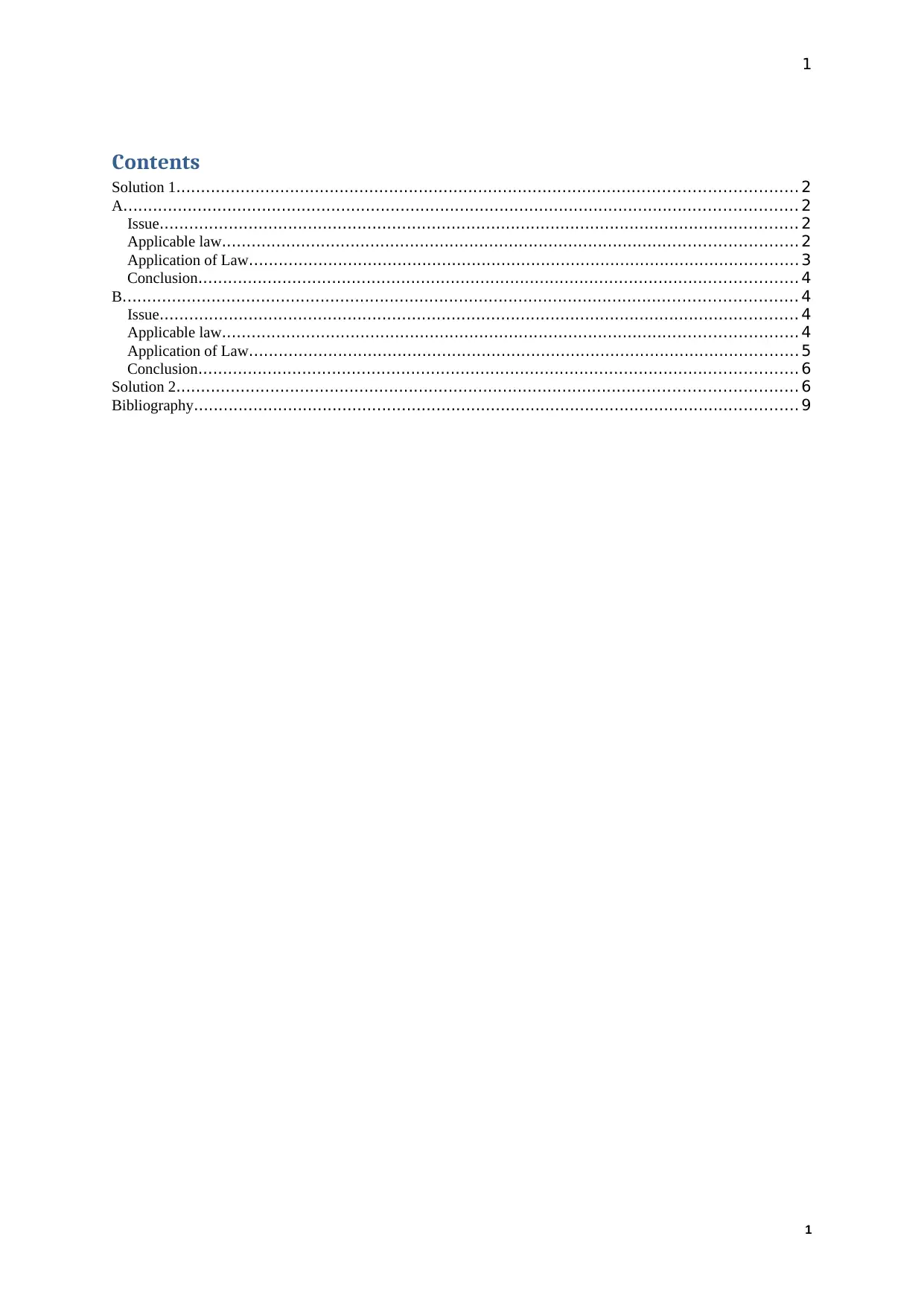
1
Contents
Solution 1............................................................................................................................. 2
A........................................................................................................................................ 2
Issue................................................................................................................................. 2
Applicable law.................................................................................................................... 2
Application of Law............................................................................................................... 3
Conclusion......................................................................................................................... 4
B........................................................................................................................................ 4
Issue................................................................................................................................. 4
Applicable law.................................................................................................................... 4
Application of Law............................................................................................................... 5
Conclusion......................................................................................................................... 6
Solution 2............................................................................................................................. 6
Bibliography.......................................................................................................................... 9
1
Contents
Solution 1............................................................................................................................. 2
A........................................................................................................................................ 2
Issue................................................................................................................................. 2
Applicable law.................................................................................................................... 2
Application of Law............................................................................................................... 3
Conclusion......................................................................................................................... 4
B........................................................................................................................................ 4
Issue................................................................................................................................. 4
Applicable law.................................................................................................................... 4
Application of Law............................................................................................................... 5
Conclusion......................................................................................................................... 6
Solution 2............................................................................................................................. 6
Bibliography.......................................................................................................................... 9
1
Secure Best Marks with AI Grader
Need help grading? Try our AI Grader for instant feedback on your assignments.
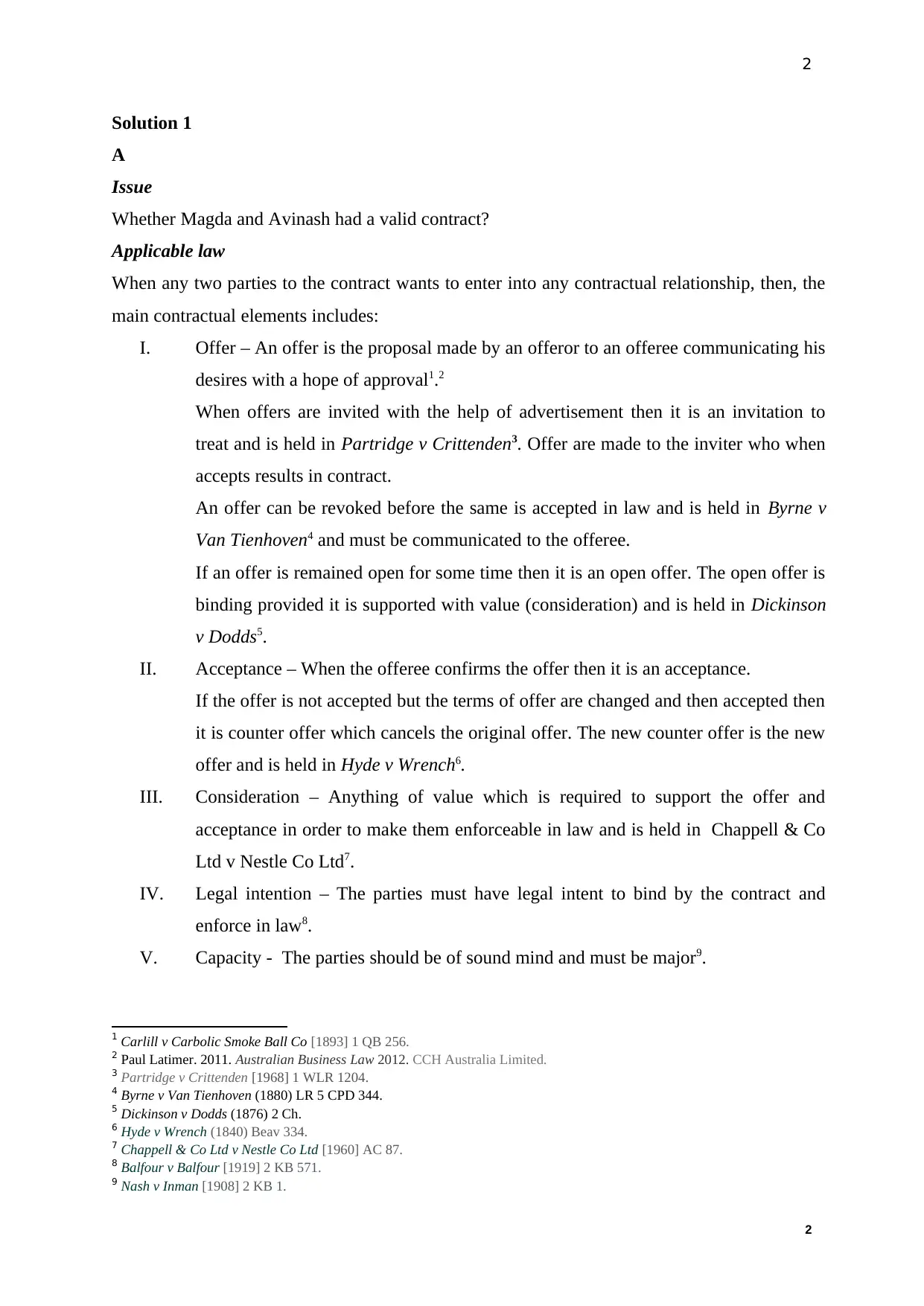
2
Solution 1
A
Issue
Whether Magda and Avinash had a valid contract?
Applicable law
When any two parties to the contract wants to enter into any contractual relationship, then, the
main contractual elements includes:
I. Offer – An offer is the proposal made by an offeror to an offeree communicating his
desires with a hope of approval1.2
When offers are invited with the help of advertisement then it is an invitation to
treat and is held in Partridge v Crittenden3. Offer are made to the inviter who when
accepts results in contract.
An offer can be revoked before the same is accepted in law and is held in Byrne v
Van Tienhoven4 and must be communicated to the offeree.
If an offer is remained open for some time then it is an open offer. The open offer is
binding provided it is supported with value (consideration) and is held in Dickinson
v Dodds5.
II. Acceptance – When the offeree confirms the offer then it is an acceptance.
If the offer is not accepted but the terms of offer are changed and then accepted then
it is counter offer which cancels the original offer. The new counter offer is the new
offer and is held in Hyde v Wrench6.
III. Consideration – Anything of value which is required to support the offer and
acceptance in order to make them enforceable in law and is held in Chappell & Co
Ltd v Nestle Co Ltd7.
IV. Legal intention – The parties must have legal intent to bind by the contract and
enforce in law8.
V. Capacity - The parties should be of sound mind and must be major9.
1 Carlill v Carbolic Smoke Ball Co [1893] 1 QB 256.
2 Paul Latimer. 2011. Australian Business Law 2012. CCH Australia Limited.
3 Partridge v Crittenden [1968] 1 WLR 1204.
4 Byrne v Van Tienhoven (1880) LR 5 CPD 344.
5 Dickinson v Dodds (1876) 2 Ch.
6 Hyde v Wrench (1840) Beav 334.
7 Chappell & Co Ltd v Nestle Co Ltd [1960] AC 87.
8 Balfour v Balfour [1919] 2 KB 571.
9 Nash v Inman [1908] 2 KB 1.
2
Solution 1
A
Issue
Whether Magda and Avinash had a valid contract?
Applicable law
When any two parties to the contract wants to enter into any contractual relationship, then, the
main contractual elements includes:
I. Offer – An offer is the proposal made by an offeror to an offeree communicating his
desires with a hope of approval1.2
When offers are invited with the help of advertisement then it is an invitation to
treat and is held in Partridge v Crittenden3. Offer are made to the inviter who when
accepts results in contract.
An offer can be revoked before the same is accepted in law and is held in Byrne v
Van Tienhoven4 and must be communicated to the offeree.
If an offer is remained open for some time then it is an open offer. The open offer is
binding provided it is supported with value (consideration) and is held in Dickinson
v Dodds5.
II. Acceptance – When the offeree confirms the offer then it is an acceptance.
If the offer is not accepted but the terms of offer are changed and then accepted then
it is counter offer which cancels the original offer. The new counter offer is the new
offer and is held in Hyde v Wrench6.
III. Consideration – Anything of value which is required to support the offer and
acceptance in order to make them enforceable in law and is held in Chappell & Co
Ltd v Nestle Co Ltd7.
IV. Legal intention – The parties must have legal intent to bind by the contract and
enforce in law8.
V. Capacity - The parties should be of sound mind and must be major9.
1 Carlill v Carbolic Smoke Ball Co [1893] 1 QB 256.
2 Paul Latimer. 2011. Australian Business Law 2012. CCH Australia Limited.
3 Partridge v Crittenden [1968] 1 WLR 1204.
4 Byrne v Van Tienhoven (1880) LR 5 CPD 344.
5 Dickinson v Dodds (1876) 2 Ch.
6 Hyde v Wrench (1840) Beav 334.
7 Chappell & Co Ltd v Nestle Co Ltd [1960] AC 87.
8 Balfour v Balfour [1919] 2 KB 571.
9 Nash v Inman [1908] 2 KB 1.
2
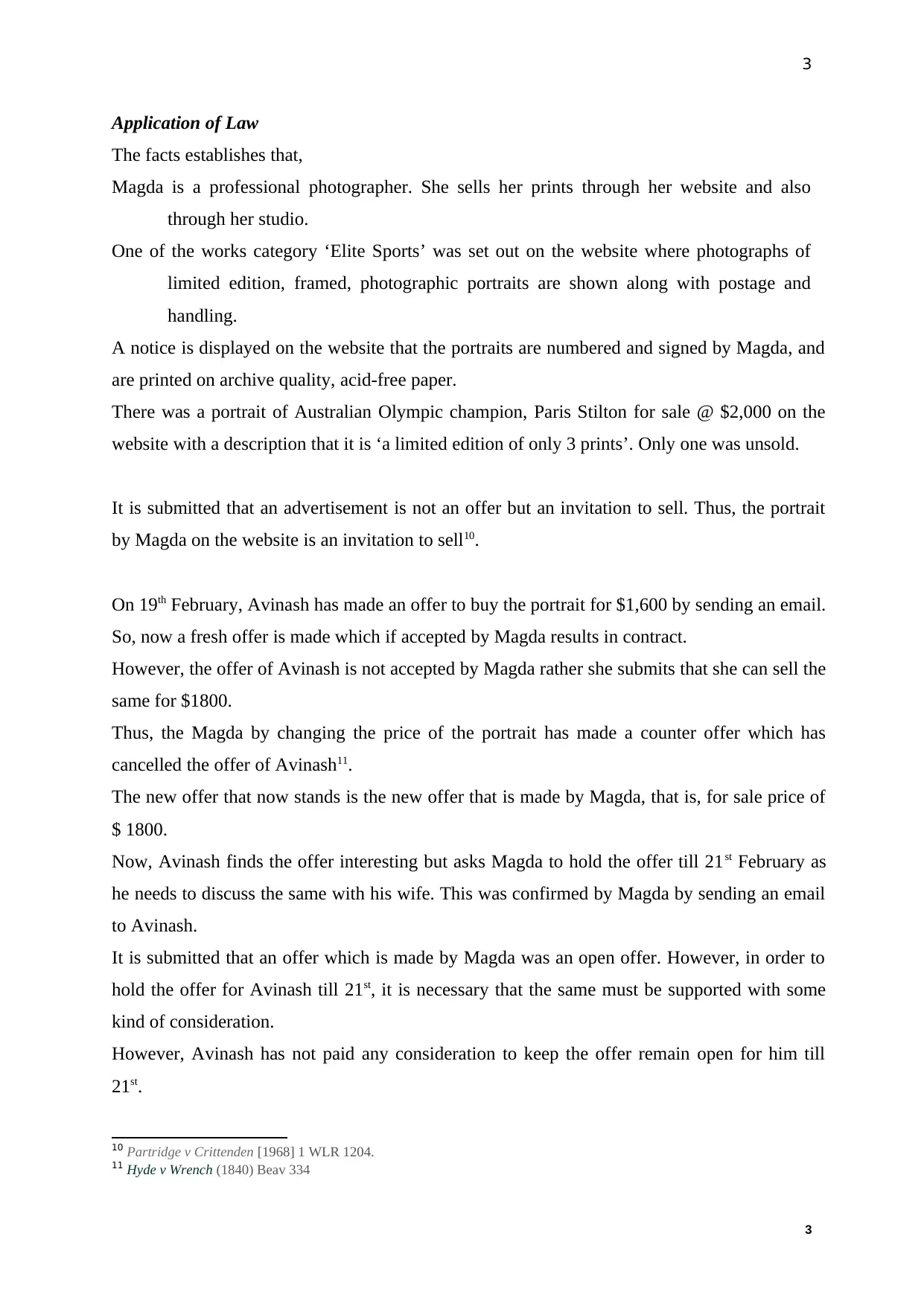
3
Application of Law
The facts establishes that,
Magda is a professional photographer. She sells her prints through her website and also
through her studio.
One of the works category ‘Elite Sports’ was set out on the website where photographs of
limited edition, framed, photographic portraits are shown along with postage and
handling.
A notice is displayed on the website that the portraits are numbered and signed by Magda, and
are printed on archive quality, acid-free paper.
There was a portrait of Australian Olympic champion, Paris Stilton for sale @ $2,000 on the
website with a description that it is ‘a limited edition of only 3 prints’. Only one was unsold.
It is submitted that an advertisement is not an offer but an invitation to sell. Thus, the portrait
by Magda on the website is an invitation to sell10.
On 19th February, Avinash has made an offer to buy the portrait for $1,600 by sending an email.
So, now a fresh offer is made which if accepted by Magda results in contract.
However, the offer of Avinash is not accepted by Magda rather she submits that she can sell the
same for $1800.
Thus, the Magda by changing the price of the portrait has made a counter offer which has
cancelled the offer of Avinash11.
The new offer that now stands is the new offer that is made by Magda, that is, for sale price of
$ 1800.
Now, Avinash finds the offer interesting but asks Magda to hold the offer till 21st February as
he needs to discuss the same with his wife. This was confirmed by Magda by sending an email
to Avinash.
It is submitted that an offer which is made by Magda was an open offer. However, in order to
hold the offer for Avinash till 21st, it is necessary that the same must be supported with some
kind of consideration.
However, Avinash has not paid any consideration to keep the offer remain open for him till
21st.
10 Partridge v Crittenden [1968] 1 WLR 1204.
11 Hyde v Wrench (1840) Beav 334
3
Application of Law
The facts establishes that,
Magda is a professional photographer. She sells her prints through her website and also
through her studio.
One of the works category ‘Elite Sports’ was set out on the website where photographs of
limited edition, framed, photographic portraits are shown along with postage and
handling.
A notice is displayed on the website that the portraits are numbered and signed by Magda, and
are printed on archive quality, acid-free paper.
There was a portrait of Australian Olympic champion, Paris Stilton for sale @ $2,000 on the
website with a description that it is ‘a limited edition of only 3 prints’. Only one was unsold.
It is submitted that an advertisement is not an offer but an invitation to sell. Thus, the portrait
by Magda on the website is an invitation to sell10.
On 19th February, Avinash has made an offer to buy the portrait for $1,600 by sending an email.
So, now a fresh offer is made which if accepted by Magda results in contract.
However, the offer of Avinash is not accepted by Magda rather she submits that she can sell the
same for $1800.
Thus, the Magda by changing the price of the portrait has made a counter offer which has
cancelled the offer of Avinash11.
The new offer that now stands is the new offer that is made by Magda, that is, for sale price of
$ 1800.
Now, Avinash finds the offer interesting but asks Magda to hold the offer till 21st February as
he needs to discuss the same with his wife. This was confirmed by Magda by sending an email
to Avinash.
It is submitted that an offer which is made by Magda was an open offer. However, in order to
hold the offer for Avinash till 21st, it is necessary that the same must be supported with some
kind of consideration.
However, Avinash has not paid any consideration to keep the offer remain open for him till
21st.
10 Partridge v Crittenden [1968] 1 WLR 1204.
11 Hyde v Wrench (1840) Beav 334
3
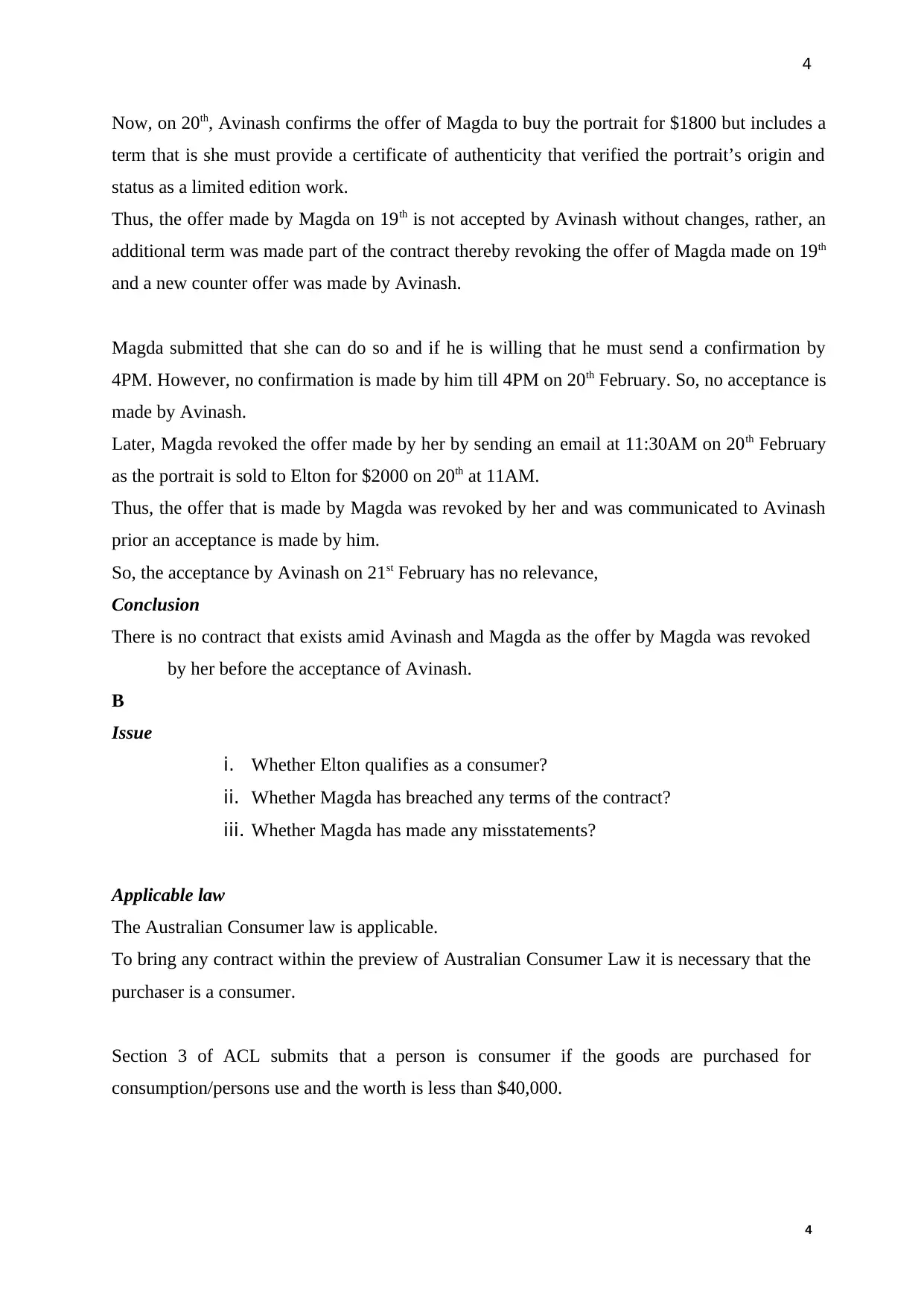
4
Now, on 20th, Avinash confirms the offer of Magda to buy the portrait for $1800 but includes a
term that is she must provide a certificate of authenticity that verified the portrait’s origin and
status as a limited edition work.
Thus, the offer made by Magda on 19th is not accepted by Avinash without changes, rather, an
additional term was made part of the contract thereby revoking the offer of Magda made on 19th
and a new counter offer was made by Avinash.
Magda submitted that she can do so and if he is willing that he must send a confirmation by
4PM. However, no confirmation is made by him till 4PM on 20th February. So, no acceptance is
made by Avinash.
Later, Magda revoked the offer made by her by sending an email at 11:30AM on 20th February
as the portrait is sold to Elton for $2000 on 20th at 11AM.
Thus, the offer that is made by Magda was revoked by her and was communicated to Avinash
prior an acceptance is made by him.
So, the acceptance by Avinash on 21st February has no relevance,
Conclusion
There is no contract that exists amid Avinash and Magda as the offer by Magda was revoked
by her before the acceptance of Avinash.
B
Issue
i. Whether Elton qualifies as a consumer?
ii. Whether Magda has breached any terms of the contract?
iii. Whether Magda has made any misstatements?
Applicable law
The Australian Consumer law is applicable.
To bring any contract within the preview of Australian Consumer Law it is necessary that the
purchaser is a consumer.
Section 3 of ACL submits that a person is consumer if the goods are purchased for
consumption/persons use and the worth is less than $40,000.
4
Now, on 20th, Avinash confirms the offer of Magda to buy the portrait for $1800 but includes a
term that is she must provide a certificate of authenticity that verified the portrait’s origin and
status as a limited edition work.
Thus, the offer made by Magda on 19th is not accepted by Avinash without changes, rather, an
additional term was made part of the contract thereby revoking the offer of Magda made on 19th
and a new counter offer was made by Avinash.
Magda submitted that she can do so and if he is willing that he must send a confirmation by
4PM. However, no confirmation is made by him till 4PM on 20th February. So, no acceptance is
made by Avinash.
Later, Magda revoked the offer made by her by sending an email at 11:30AM on 20th February
as the portrait is sold to Elton for $2000 on 20th at 11AM.
Thus, the offer that is made by Magda was revoked by her and was communicated to Avinash
prior an acceptance is made by him.
So, the acceptance by Avinash on 21st February has no relevance,
Conclusion
There is no contract that exists amid Avinash and Magda as the offer by Magda was revoked
by her before the acceptance of Avinash.
B
Issue
i. Whether Elton qualifies as a consumer?
ii. Whether Magda has breached any terms of the contract?
iii. Whether Magda has made any misstatements?
Applicable law
The Australian Consumer law is applicable.
To bring any contract within the preview of Australian Consumer Law it is necessary that the
purchaser is a consumer.
Section 3 of ACL submits that a person is consumer if the goods are purchased for
consumption/persons use and the worth is less than $40,000.
4
Secure Best Marks with AI Grader
Need help grading? Try our AI Grader for instant feedback on your assignments.
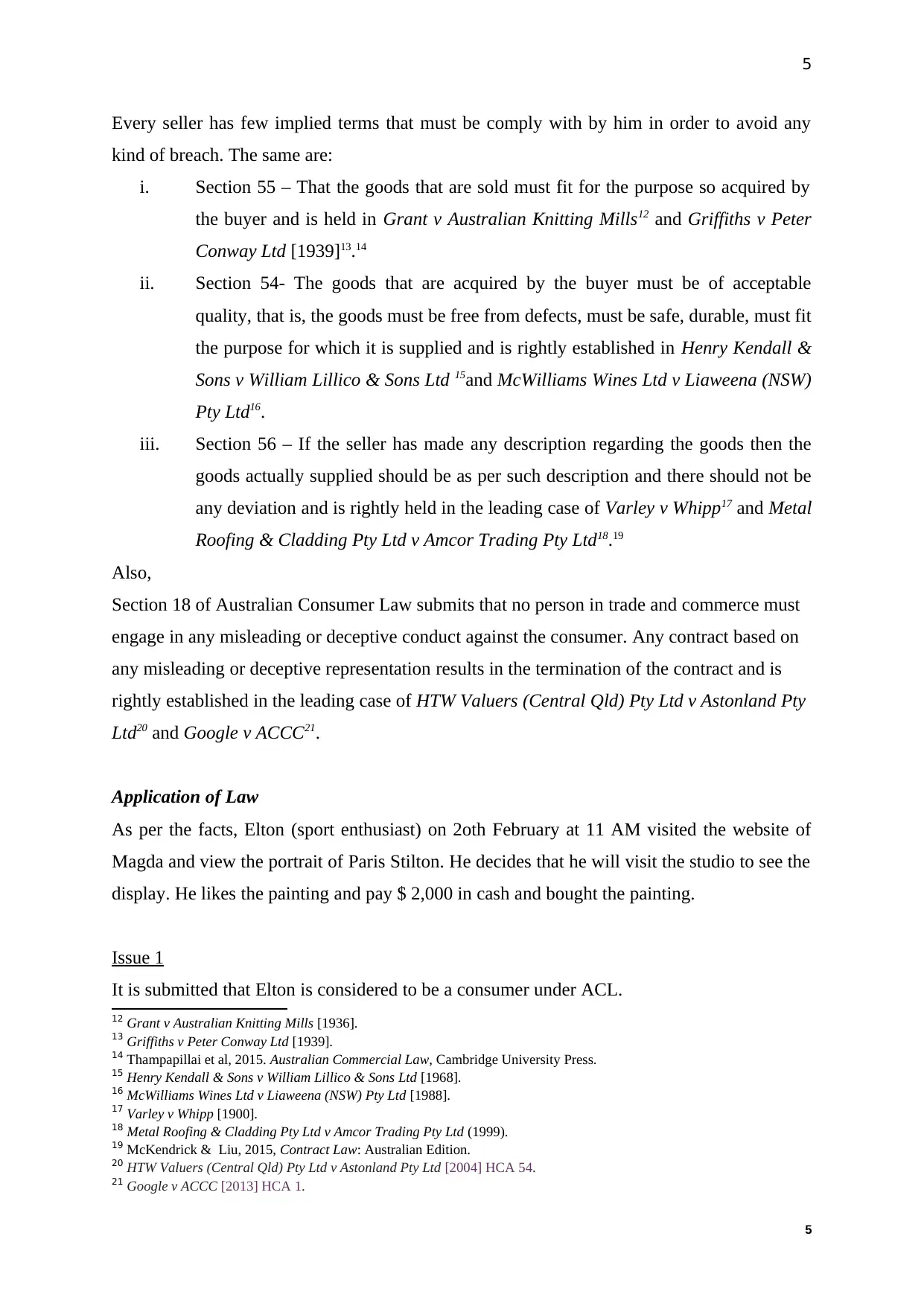
5
Every seller has few implied terms that must be comply with by him in order to avoid any
kind of breach. The same are:
i. Section 55 – That the goods that are sold must fit for the purpose so acquired by
the buyer and is held in Grant v Australian Knitting Mills12 and Griffiths v Peter
Conway Ltd [1939]13.14
ii. Section 54- The goods that are acquired by the buyer must be of acceptable
quality, that is, the goods must be free from defects, must be safe, durable, must fit
the purpose for which it is supplied and is rightly established in Henry Kendall &
Sons v William Lillico & Sons Ltd 15and McWilliams Wines Ltd v Liaweena (NSW)
Pty Ltd16.
iii. Section 56 – If the seller has made any description regarding the goods then the
goods actually supplied should be as per such description and there should not be
any deviation and is rightly held in the leading case of Varley v Whipp17 and Metal
Roofing & Cladding Pty Ltd v Amcor Trading Pty Ltd18.19
Also,
Section 18 of Australian Consumer Law submits that no person in trade and commerce must
engage in any misleading or deceptive conduct against the consumer. Any contract based on
any misleading or deceptive representation results in the termination of the contract and is
rightly established in the leading case of HTW Valuers (Central Qld) Pty Ltd v Astonland Pty
Ltd20 and Google v ACCC21.
Application of Law
As per the facts, Elton (sport enthusiast) on 2oth February at 11 AM visited the website of
Magda and view the portrait of Paris Stilton. He decides that he will visit the studio to see the
display. He likes the painting and pay $ 2,000 in cash and bought the painting.
Issue 1
It is submitted that Elton is considered to be a consumer under ACL.
12 Grant v Australian Knitting Mills [1936].
13 Griffiths v Peter Conway Ltd [1939].
14 Thampapillai et al, 2015. Australian Commercial Law, Cambridge University Press.
15 Henry Kendall & Sons v William Lillico & Sons Ltd [1968].
16 McWilliams Wines Ltd v Liaweena (NSW) Pty Ltd [1988].
17 Varley v Whipp [1900].
18 Metal Roofing & Cladding Pty Ltd v Amcor Trading Pty Ltd (1999).
19 McKendrick & Liu, 2015, Contract Law: Australian Edition.
20 HTW Valuers (Central Qld) Pty Ltd v Astonland Pty Ltd [2004] HCA 54.
21 Google v ACCC [2013] HCA 1.
5
Every seller has few implied terms that must be comply with by him in order to avoid any
kind of breach. The same are:
i. Section 55 – That the goods that are sold must fit for the purpose so acquired by
the buyer and is held in Grant v Australian Knitting Mills12 and Griffiths v Peter
Conway Ltd [1939]13.14
ii. Section 54- The goods that are acquired by the buyer must be of acceptable
quality, that is, the goods must be free from defects, must be safe, durable, must fit
the purpose for which it is supplied and is rightly established in Henry Kendall &
Sons v William Lillico & Sons Ltd 15and McWilliams Wines Ltd v Liaweena (NSW)
Pty Ltd16.
iii. Section 56 – If the seller has made any description regarding the goods then the
goods actually supplied should be as per such description and there should not be
any deviation and is rightly held in the leading case of Varley v Whipp17 and Metal
Roofing & Cladding Pty Ltd v Amcor Trading Pty Ltd18.19
Also,
Section 18 of Australian Consumer Law submits that no person in trade and commerce must
engage in any misleading or deceptive conduct against the consumer. Any contract based on
any misleading or deceptive representation results in the termination of the contract and is
rightly established in the leading case of HTW Valuers (Central Qld) Pty Ltd v Astonland Pty
Ltd20 and Google v ACCC21.
Application of Law
As per the facts, Elton (sport enthusiast) on 2oth February at 11 AM visited the website of
Magda and view the portrait of Paris Stilton. He decides that he will visit the studio to see the
display. He likes the painting and pay $ 2,000 in cash and bought the painting.
Issue 1
It is submitted that Elton is considered to be a consumer under ACL.
12 Grant v Australian Knitting Mills [1936].
13 Griffiths v Peter Conway Ltd [1939].
14 Thampapillai et al, 2015. Australian Commercial Law, Cambridge University Press.
15 Henry Kendall & Sons v William Lillico & Sons Ltd [1968].
16 McWilliams Wines Ltd v Liaweena (NSW) Pty Ltd [1988].
17 Varley v Whipp [1900].
18 Metal Roofing & Cladding Pty Ltd v Amcor Trading Pty Ltd (1999).
19 McKendrick & Liu, 2015, Contract Law: Australian Edition.
20 HTW Valuers (Central Qld) Pty Ltd v Astonland Pty Ltd [2004] HCA 54.
21 Google v ACCC [2013] HCA 1.
5
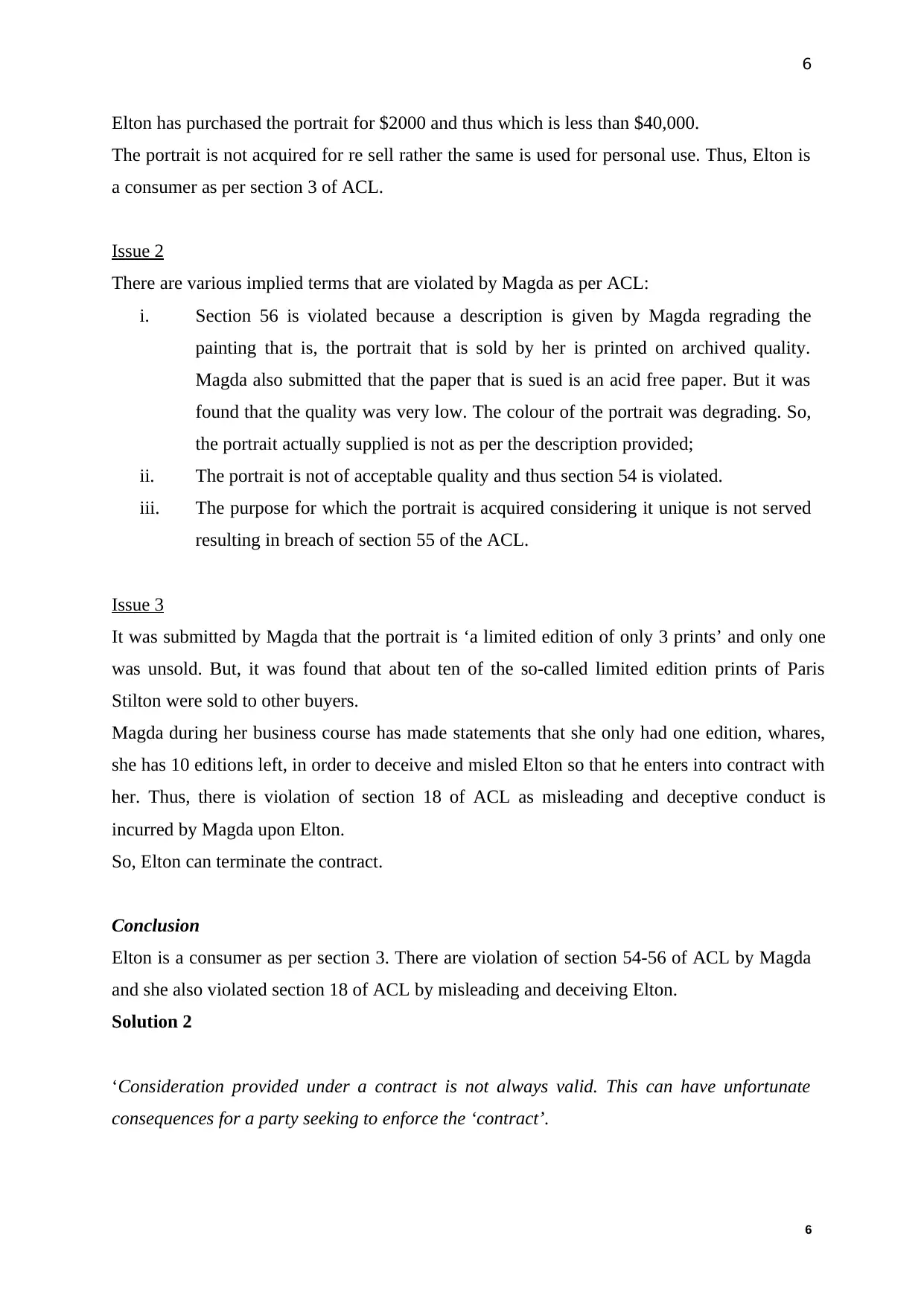
6
Elton has purchased the portrait for $2000 and thus which is less than $40,000.
The portrait is not acquired for re sell rather the same is used for personal use. Thus, Elton is
a consumer as per section 3 of ACL.
Issue 2
There are various implied terms that are violated by Magda as per ACL:
i. Section 56 is violated because a description is given by Magda regrading the
painting that is, the portrait that is sold by her is printed on archived quality.
Magda also submitted that the paper that is sued is an acid free paper. But it was
found that the quality was very low. The colour of the portrait was degrading. So,
the portrait actually supplied is not as per the description provided;
ii. The portrait is not of acceptable quality and thus section 54 is violated.
iii. The purpose for which the portrait is acquired considering it unique is not served
resulting in breach of section 55 of the ACL.
Issue 3
It was submitted by Magda that the portrait is ‘a limited edition of only 3 prints’ and only one
was unsold. But, it was found that about ten of the so-called limited edition prints of Paris
Stilton were sold to other buyers.
Magda during her business course has made statements that she only had one edition, whares,
she has 10 editions left, in order to deceive and misled Elton so that he enters into contract with
her. Thus, there is violation of section 18 of ACL as misleading and deceptive conduct is
incurred by Magda upon Elton.
So, Elton can terminate the contract.
Conclusion
Elton is a consumer as per section 3. There are violation of section 54-56 of ACL by Magda
and she also violated section 18 of ACL by misleading and deceiving Elton.
Solution 2
‘Consideration provided under a contract is not always valid. This can have unfortunate
consequences for a party seeking to enforce the ‘contract’.
6
Elton has purchased the portrait for $2000 and thus which is less than $40,000.
The portrait is not acquired for re sell rather the same is used for personal use. Thus, Elton is
a consumer as per section 3 of ACL.
Issue 2
There are various implied terms that are violated by Magda as per ACL:
i. Section 56 is violated because a description is given by Magda regrading the
painting that is, the portrait that is sold by her is printed on archived quality.
Magda also submitted that the paper that is sued is an acid free paper. But it was
found that the quality was very low. The colour of the portrait was degrading. So,
the portrait actually supplied is not as per the description provided;
ii. The portrait is not of acceptable quality and thus section 54 is violated.
iii. The purpose for which the portrait is acquired considering it unique is not served
resulting in breach of section 55 of the ACL.
Issue 3
It was submitted by Magda that the portrait is ‘a limited edition of only 3 prints’ and only one
was unsold. But, it was found that about ten of the so-called limited edition prints of Paris
Stilton were sold to other buyers.
Magda during her business course has made statements that she only had one edition, whares,
she has 10 editions left, in order to deceive and misled Elton so that he enters into contract with
her. Thus, there is violation of section 18 of ACL as misleading and deceptive conduct is
incurred by Magda upon Elton.
So, Elton can terminate the contract.
Conclusion
Elton is a consumer as per section 3. There are violation of section 54-56 of ACL by Magda
and she also violated section 18 of ACL by misleading and deceiving Elton.
Solution 2
‘Consideration provided under a contract is not always valid. This can have unfortunate
consequences for a party seeking to enforce the ‘contract’.
6
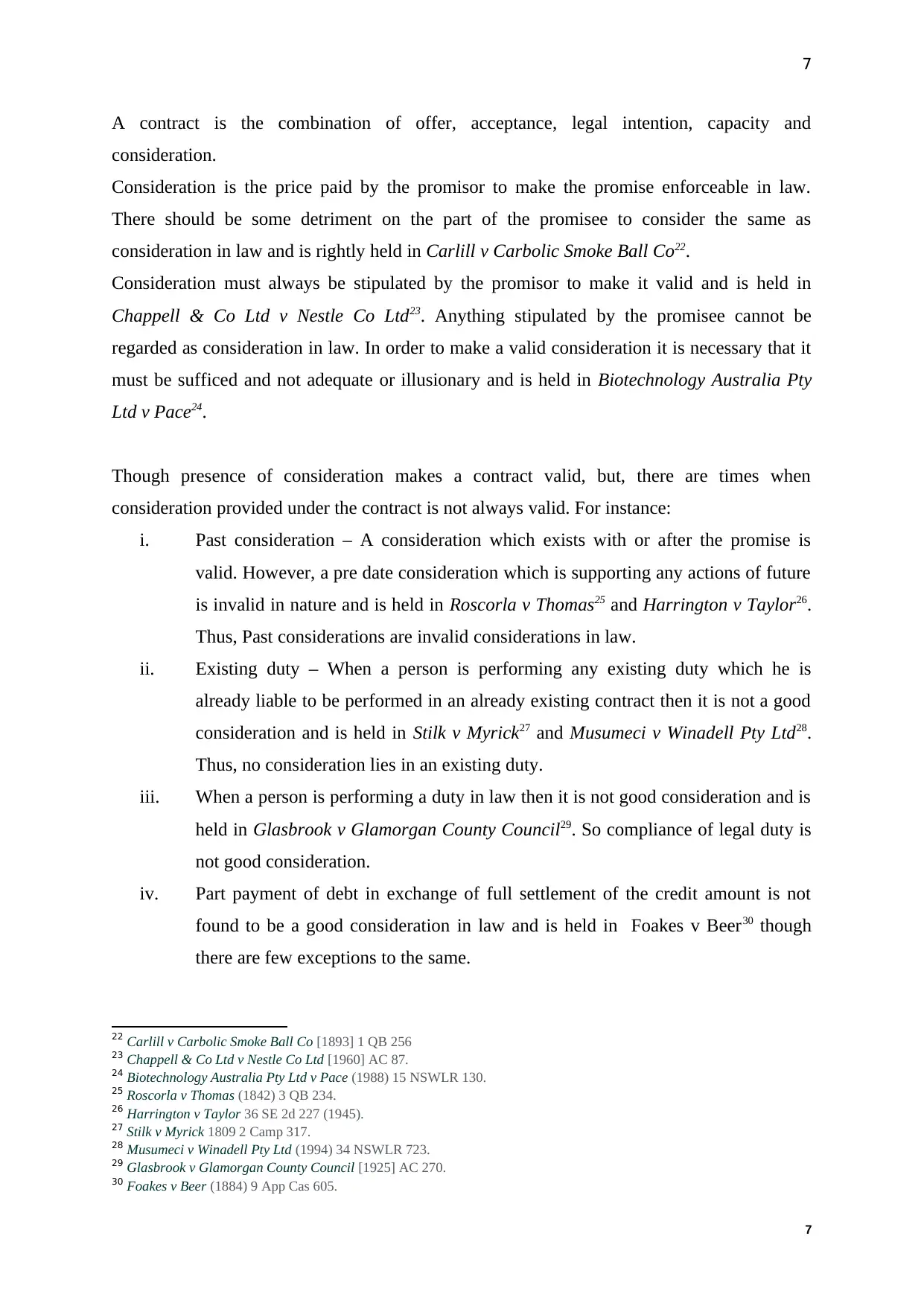
7
A contract is the combination of offer, acceptance, legal intention, capacity and
consideration.
Consideration is the price paid by the promisor to make the promise enforceable in law.
There should be some detriment on the part of the promisee to consider the same as
consideration in law and is rightly held in Carlill v Carbolic Smoke Ball Co22.
Consideration must always be stipulated by the promisor to make it valid and is held in
Chappell & Co Ltd v Nestle Co Ltd23. Anything stipulated by the promisee cannot be
regarded as consideration in law. In order to make a valid consideration it is necessary that it
must be sufficed and not adequate or illusionary and is held in Biotechnology Australia Pty
Ltd v Pace24.
Though presence of consideration makes a contract valid, but, there are times when
consideration provided under the contract is not always valid. For instance:
i. Past consideration – A consideration which exists with or after the promise is
valid. However, a pre date consideration which is supporting any actions of future
is invalid in nature and is held in Roscorla v Thomas25 and Harrington v Taylor26.
Thus, Past considerations are invalid considerations in law.
ii. Existing duty – When a person is performing any existing duty which he is
already liable to be performed in an already existing contract then it is not a good
consideration and is held in Stilk v Myrick27 and Musumeci v Winadell Pty Ltd28.
Thus, no consideration lies in an existing duty.
iii. When a person is performing a duty in law then it is not good consideration and is
held in Glasbrook v Glamorgan County Council29. So compliance of legal duty is
not good consideration.
iv. Part payment of debt in exchange of full settlement of the credit amount is not
found to be a good consideration in law and is held in Foakes v Beer30 though
there are few exceptions to the same.
22 Carlill v Carbolic Smoke Ball Co [1893] 1 QB 256
23 Chappell & Co Ltd v Nestle Co Ltd [1960] AC 87.
24 Biotechnology Australia Pty Ltd v Pace (1988) 15 NSWLR 130.
25 Roscorla v Thomas (1842) 3 QB 234.
26 Harrington v Taylor 36 SE 2d 227 (1945).
27 Stilk v Myrick 1809 2 Camp 317.
28 Musumeci v Winadell Pty Ltd (1994) 34 NSWLR 723.
29 Glasbrook v Glamorgan County Council [1925] AC 270.
30 Foakes v Beer (1884) 9 App Cas 605.
7
A contract is the combination of offer, acceptance, legal intention, capacity and
consideration.
Consideration is the price paid by the promisor to make the promise enforceable in law.
There should be some detriment on the part of the promisee to consider the same as
consideration in law and is rightly held in Carlill v Carbolic Smoke Ball Co22.
Consideration must always be stipulated by the promisor to make it valid and is held in
Chappell & Co Ltd v Nestle Co Ltd23. Anything stipulated by the promisee cannot be
regarded as consideration in law. In order to make a valid consideration it is necessary that it
must be sufficed and not adequate or illusionary and is held in Biotechnology Australia Pty
Ltd v Pace24.
Though presence of consideration makes a contract valid, but, there are times when
consideration provided under the contract is not always valid. For instance:
i. Past consideration – A consideration which exists with or after the promise is
valid. However, a pre date consideration which is supporting any actions of future
is invalid in nature and is held in Roscorla v Thomas25 and Harrington v Taylor26.
Thus, Past considerations are invalid considerations in law.
ii. Existing duty – When a person is performing any existing duty which he is
already liable to be performed in an already existing contract then it is not a good
consideration and is held in Stilk v Myrick27 and Musumeci v Winadell Pty Ltd28.
Thus, no consideration lies in an existing duty.
iii. When a person is performing a duty in law then it is not good consideration and is
held in Glasbrook v Glamorgan County Council29. So compliance of legal duty is
not good consideration.
iv. Part payment of debt in exchange of full settlement of the credit amount is not
found to be a good consideration in law and is held in Foakes v Beer30 though
there are few exceptions to the same.
22 Carlill v Carbolic Smoke Ball Co [1893] 1 QB 256
23 Chappell & Co Ltd v Nestle Co Ltd [1960] AC 87.
24 Biotechnology Australia Pty Ltd v Pace (1988) 15 NSWLR 130.
25 Roscorla v Thomas (1842) 3 QB 234.
26 Harrington v Taylor 36 SE 2d 227 (1945).
27 Stilk v Myrick 1809 2 Camp 317.
28 Musumeci v Winadell Pty Ltd (1994) 34 NSWLR 723.
29 Glasbrook v Glamorgan County Council [1925] AC 270.
30 Foakes v Beer (1884) 9 App Cas 605.
7
Paraphrase This Document
Need a fresh take? Get an instant paraphrase of this document with our AI Paraphraser
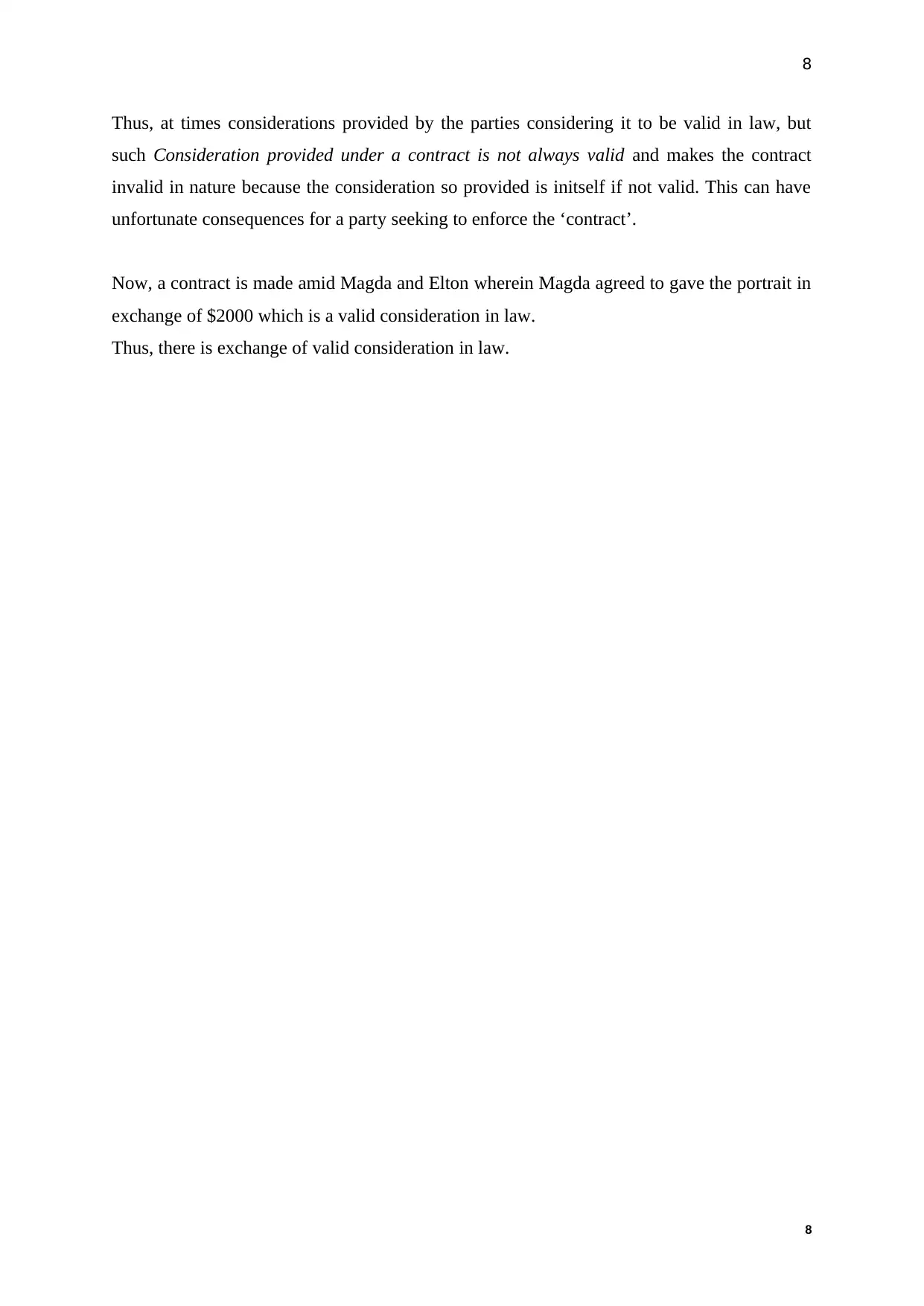
8
Thus, at times considerations provided by the parties considering it to be valid in law, but
such Consideration provided under a contract is not always valid and makes the contract
invalid in nature because the consideration so provided is initself if not valid. This can have
unfortunate consequences for a party seeking to enforce the ‘contract’.
Now, a contract is made amid Magda and Elton wherein Magda agreed to gave the portrait in
exchange of $2000 which is a valid consideration in law.
Thus, there is exchange of valid consideration in law.
8
Thus, at times considerations provided by the parties considering it to be valid in law, but
such Consideration provided under a contract is not always valid and makes the contract
invalid in nature because the consideration so provided is initself if not valid. This can have
unfortunate consequences for a party seeking to enforce the ‘contract’.
Now, a contract is made amid Magda and Elton wherein Magda agreed to gave the portrait in
exchange of $2000 which is a valid consideration in law.
Thus, there is exchange of valid consideration in law.
8
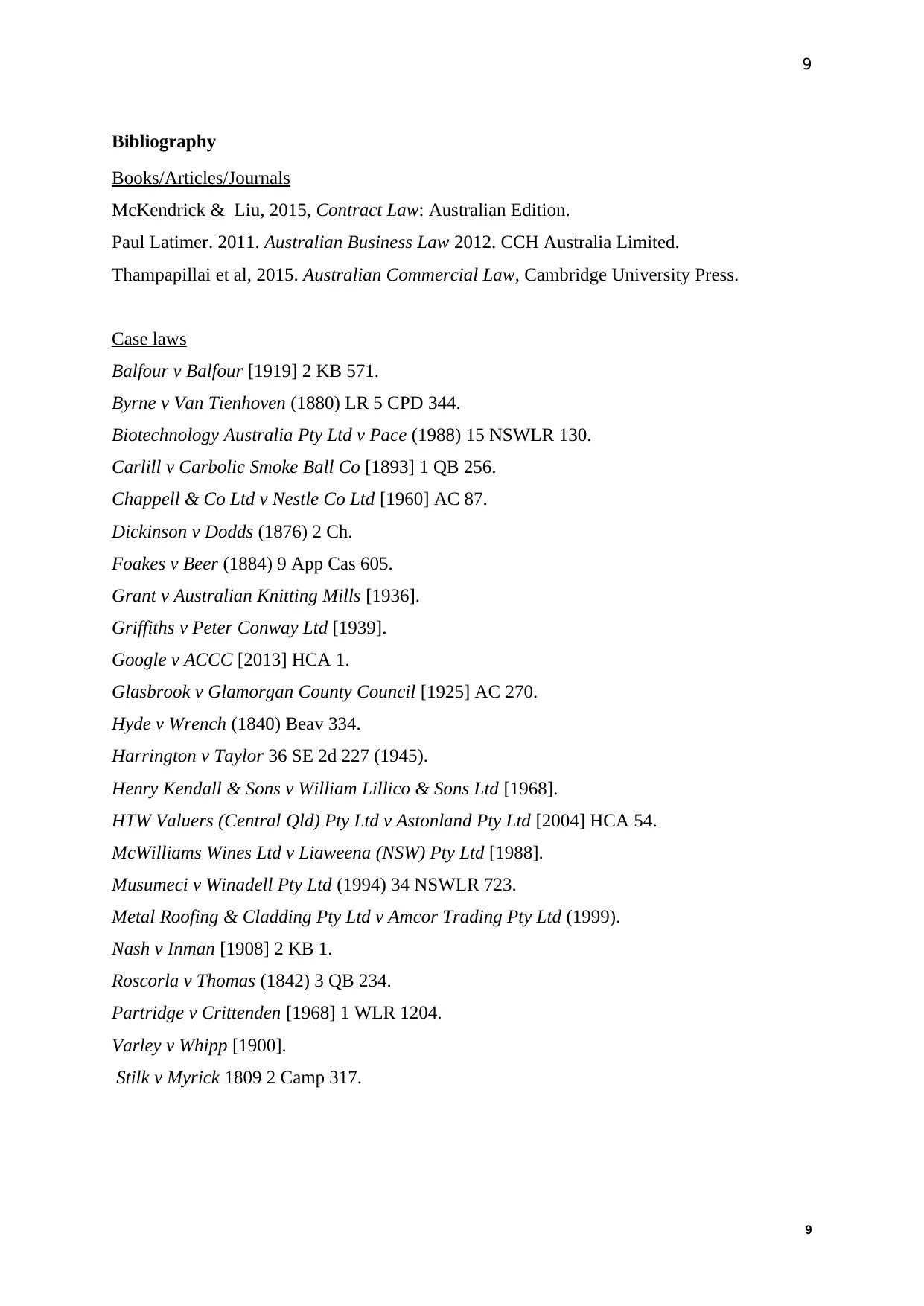
9
Bibliography
Books/Articles/Journals
McKendrick & Liu, 2015, Contract Law: Australian Edition.
Paul Latimer. 2011. Australian Business Law 2012. CCH Australia Limited.
Thampapillai et al, 2015. Australian Commercial Law, Cambridge University Press.
Case laws
Balfour v Balfour [1919] 2 KB 571.
Byrne v Van Tienhoven (1880) LR 5 CPD 344.
Biotechnology Australia Pty Ltd v Pace (1988) 15 NSWLR 130.
Carlill v Carbolic Smoke Ball Co [1893] 1 QB 256.
Chappell & Co Ltd v Nestle Co Ltd [1960] AC 87.
Dickinson v Dodds (1876) 2 Ch.
Foakes v Beer (1884) 9 App Cas 605.
Grant v Australian Knitting Mills [1936].
Griffiths v Peter Conway Ltd [1939].
Google v ACCC [2013] HCA 1.
Glasbrook v Glamorgan County Council [1925] AC 270.
Hyde v Wrench (1840) Beav 334.
Harrington v Taylor 36 SE 2d 227 (1945).
Henry Kendall & Sons v William Lillico & Sons Ltd [1968].
HTW Valuers (Central Qld) Pty Ltd v Astonland Pty Ltd [2004] HCA 54.
McWilliams Wines Ltd v Liaweena (NSW) Pty Ltd [1988].
Musumeci v Winadell Pty Ltd (1994) 34 NSWLR 723.
Metal Roofing & Cladding Pty Ltd v Amcor Trading Pty Ltd (1999).
Nash v Inman [1908] 2 KB 1.
Roscorla v Thomas (1842) 3 QB 234.
Partridge v Crittenden [1968] 1 WLR 1204.
Varley v Whipp [1900].
Stilk v Myrick 1809 2 Camp 317.
9
Bibliography
Books/Articles/Journals
McKendrick & Liu, 2015, Contract Law: Australian Edition.
Paul Latimer. 2011. Australian Business Law 2012. CCH Australia Limited.
Thampapillai et al, 2015. Australian Commercial Law, Cambridge University Press.
Case laws
Balfour v Balfour [1919] 2 KB 571.
Byrne v Van Tienhoven (1880) LR 5 CPD 344.
Biotechnology Australia Pty Ltd v Pace (1988) 15 NSWLR 130.
Carlill v Carbolic Smoke Ball Co [1893] 1 QB 256.
Chappell & Co Ltd v Nestle Co Ltd [1960] AC 87.
Dickinson v Dodds (1876) 2 Ch.
Foakes v Beer (1884) 9 App Cas 605.
Grant v Australian Knitting Mills [1936].
Griffiths v Peter Conway Ltd [1939].
Google v ACCC [2013] HCA 1.
Glasbrook v Glamorgan County Council [1925] AC 270.
Hyde v Wrench (1840) Beav 334.
Harrington v Taylor 36 SE 2d 227 (1945).
Henry Kendall & Sons v William Lillico & Sons Ltd [1968].
HTW Valuers (Central Qld) Pty Ltd v Astonland Pty Ltd [2004] HCA 54.
McWilliams Wines Ltd v Liaweena (NSW) Pty Ltd [1988].
Musumeci v Winadell Pty Ltd (1994) 34 NSWLR 723.
Metal Roofing & Cladding Pty Ltd v Amcor Trading Pty Ltd (1999).
Nash v Inman [1908] 2 KB 1.
Roscorla v Thomas (1842) 3 QB 234.
Partridge v Crittenden [1968] 1 WLR 1204.
Varley v Whipp [1900].
Stilk v Myrick 1809 2 Camp 317.
9
1 out of 9
Related Documents
Your All-in-One AI-Powered Toolkit for Academic Success.
+13062052269
info@desklib.com
Available 24*7 on WhatsApp / Email
![[object Object]](/_next/static/media/star-bottom.7253800d.svg)
Unlock your academic potential
© 2024 | Zucol Services PVT LTD | All rights reserved.





